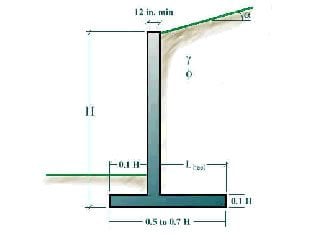Bricks can be laid in two skins which can be held together by mesh or built as a 225mm thick wall as shown in the laying bricks project.
How thick should my concrete retaining wall be.
How deep should the footing be for a retaining wall.
For plain concrete walls which are walls without or with little reinforcement 7 1 2 inch thickness is adequate.
A wall any higher than this needs to be thicker and there are several ways of achieving this.
Poured concrete foundation walls that are less than 8 feet tall and have soil outside that is 6 or 7 feet deep against the wall can often be 8 inches thick and function quite well.
The minimum thickness is also determined by wall height soil classification and the height of unbalanced backfill or backfill on only one side of the wall.
The footing dimensions will largely be determined by the size of the wall.
Mortared or concrete walls in heavy frost areas require footings dug below the frost line.
How thick should a concrete retaining wall be.
This can add several inches to the wall s thickness dimensions and can vary depending on the severity of exposure soil type and reactivity etc.
For example if you are pouring a retaining wall that will be 12 inches thick and will use wooden planks that are 1 1 2 inches thick for your forms you ll need to space the stakes about 15 inches apart 12 inches for the retaining wall plus two pieces of 1 1 2 inch thick wooden board.
In addition to basic structural requirements wall dimensions generally member thickness are also affected by the required minimum reinforcement cover.
In general poured concrete basement walls that are 8 feet tall or less and have no more than 7 feet of soil pressing against them from the outside function well at a thickness of 8 inches.
Determine the planned wall s height and width.
That s why all strong retaining walls begin with landscape fabric backfill and 4 inch perforated drainpipe.
No matter if you choose to build your retaining wall out of block brick stone wood or concrete the goal should be to integrate the retaining wall into your landscape.
Cover the gravel between your retaining wall and landscape with topsoil or sod so your garden will grow against your wall achieving a natural look.
When a taller wall or a higher level of soil or both come into play the thickness should increase to 10 inches.
The depth you need to excavate depends on frost depth as well as the wall and soil type.
As soon as you go higher or have greater depths of soil pushing against the wall you need to increase the thickness to 10 inches.
A poured concrete footing for concrete block or brick walls should be at least twice as wide as the planned wall.
A garden retaining wall of up to 400mm high can be built out of a single skin wall of facing bricks or concrete block.
The angle of a sloping lawn should never be greater than 45 degrees and the gentler the slope the better.









